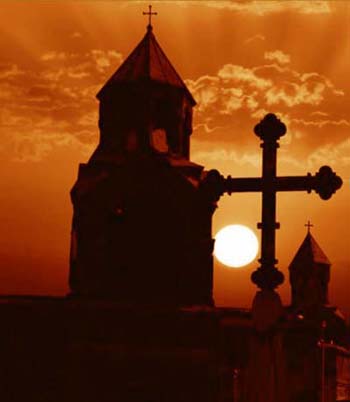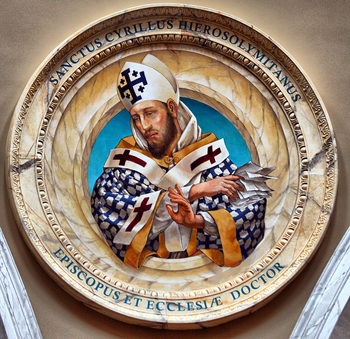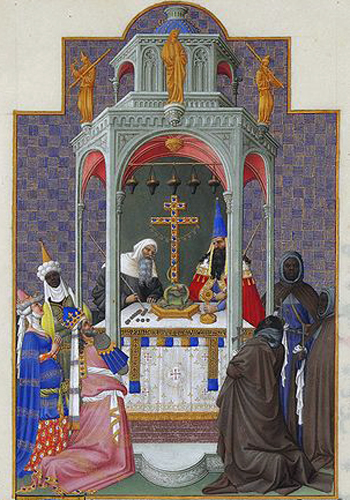 |
Stories & Legends
Apparition of the Holy Cross over Jerusalem
Hugh O’Reilly
It was called by the people “the day the sky caught fire.” At about 9 in the morning on May 7, 351, the feast of the Pentecost, the people of Jerusalem gathered in the streets, pointing to the sky in frightened shock. Tongues of flame were roaring across the horizon forming a gigantic blazing Cross in the sky. The apparition, “brighter than the sun,” extended from Golgotha to the Mount of Olives – about two miles – and was seen by everyone in Jerusalem. It remained extended over the city for several hours.
Many people fell to their knees, beseeching God to spare them from annihilation. Others went to the Churches to pray and ask forgiveness for their sins. But one man, the newly elected Patriarch of Jerusalem Cyril (315-386) bowed his head and gave thanks to God for this blazing sign from Heaven.

A flaming cross appeared over the Holy City |
At that time, the Church and people of the Holy City were divided and fractured over the Arian heresy. The Patriarch Cyril repudiated its false teaching on the Three Persons, and that strong heretical faction was threatening him with exile. In this difficult situation, he was beseeching Heaven for help. The sudden appearance of the blazing Cross in the sky was for him an answer to that prayer.
Shortly after the miraculous event, St. Cyril wrote a letter known today as the Letter to the Emperor Constantius, the son of Constantine the Great, describing the miracle in vivid detail and making it clear that the miracle was a sign from God. The letter reads:
"On the nones [or 7th] of May, about the Terce hour [or nine in the morning], a vast luminous body, in the form of a Cross, appeared in the sky just over the holy Golgotha, reaching as far as the holy Mount of Olives, seen not only by one or two persons, but clearly and evidently by the whole city. This was not, as may be thought, a momentary transient phenomenon: for it continued several hours visible to our eyes, and brighter than the sun, the light of which would have eclipsed it, had not this been stronger.
“The whole city, struck with a reverential fear tempered with joy, ran immediately to the church, young and old, Christians and heathens, citizens and strangers, all with one voice giving praise to our Lord Jesus Christ, the only Son of God, the worker of miracles; finding by experience the truth of the Christian doctrine, to which Heaven bears witness." (PG 33:116q)
He concludes his letter with wishes that the Emperor may always glorify the holy and consubstantial Trinity.
Many others also interpreted the sign that Almighty God favored St. Cyril in the struggle against the Arian heresy. Not only did many Arians abandon their heresy, but, as the historian Socrates the Scholar reports, “It was the means of the conversion of many pagans and Jews to Christianity.”
A sign reported by historians of the time
Historians of the time, including Sozomen, Theophanes, Eutychius, John of Nice, Glycas, and others, quote St. Cyril concerning this marvel. Socrates Scholasticus, author of a seven-book Ecclesiastical History, writes:

St. Cyril composed a letter to Constantius telling of the prodigy |
"At the time that Cyril administered the Church of Jerusalem after Maximus, the sign of the Cross appeared in the sky. It shone brilliantly, not with divergent rays like a comet, but with the concentration of a great deal of light, apparently dense and yet transparent. Its length was about 15 stadia (two miles) from Calvary to the Mount of Olives, and its breadth was in proportion to its length.
“So extraordinary a phenomenon excited universal terror. Men, women, and children left their houses, the market place, or their respective employments, and ran to the church, where together they sang hymns to Christ, and voluntarily confessed their belief in God. Reports of it disturbed in no little measure our entire dominions, and this happened rapidly; for, as the custom was, there were travelers from every part of the world who were dwelling at Jerusalem for prayer, or to visit its places of interest. These were spectators of the sign, and divulged the facts to their friends at home.
“The Emperor was made acquainted with the occurrence, partly by numerous reports concerning it which were then current, and partly by a letter from Cyril the Bishop. It was said that this prodigy was a fulfillment of an ancient prophecy contained in the Holy Scriptures [Mt 24:30]. It was the means of the conversion of many pagans and Jews to Christianity." (Ecclesiastical History, book 4, chapter 5)
A sign of the victory over paganism
The historian Philostorgius attributed this sign as representing the victory of the Emperor Constantius II (337-361) and his army over the commander Magnentius, who favored the pagans, and affirmed it could be seen by the troops of both Constantius and Magnentius, encouraging the former and frightening the latter:
"It appeared at Jerusalem about the Terce hour of the day which is called the day of Pentecost. This sign, which was portrayed by no human hand, was seen to stretch from the Mount of Calvary to the Mount of Olives, and was accompanied by a large rainbow, like a crown, which surrounded it on all sides. The rainbow, indeed, signified the mercy of Jesus Christ crucified and taken up into Heaven, and the crown denoted the victory of the Emperor Constantius.

The exaltation of the Holy Cross, in the Tres Riches Heures du Duc de Berry |
“Moreover, that splendid and venerable sign did not escape the notice even of the soldiers. But though it was clearly seen by both armies, it frightened above all measure Magnentius and his partisans, who were addicted to superstitious practices; while, on the other hand, it inspired Constantius and his army with invincible bravery. Magnentius, however, having suffered this defeat from Constantius, afterwards recovered his strength by degrees, and, engaging with him in a second battle, was entirely defeated [at the Battle of Mursa Major in 351] and fled away to Lyons with the loss of nearly all his army." (Ecclesiastical History, book 3, chapter 26)
Devotion to the Holy Cross
The Armenians have a great devotion to the Holy Cross, and in their liturgical calendar they celebrate four feasts in its honor. The most important is the Feast of the Exaltation of the Holy Cross on the Sunday nearest September 14. It commemorates the rescue of the Holy Cross from the Persians in 629.
The Feast of the Holy Cross of Varak, commemorating the third century placement of an authentic relic of the Cross in Armenian soil at Varagavank as protection against invaders, is on the Sunday nearest September 28. On the Sunday closest to October 26 is the feast of The Discovery of the Holy Cross, commemorating the finding of the True Cross by St. Helena in 327. The Feast of the Apparition of the Holy Cross over Jerusalem is celebrated in the Armenian Catholic Rite on the fourth Sunday after Easter, and St. Cyril’s Letter to Constantius is read after the Gospel at all the Masses.
That flaming Cross over Jerusalem, the symbol of the victory of Christ over death, can be seen as a sign of hope for our days. Then, the Arian heresy was raging and St. Cyril rightly saw it as a sign of the triumph of the Catholic doctrine over error.
Today, the heresy of Progressivism has infiltrated the whole Church, from top to bottom. The faithful have reason to ask Heaven for a sign to strengthen them in the fight. Certainly, what God has done in the past He will do again in the future in an even more marvelous way, in order to return the Church to path of fidelity and restore all her former glory.

Posted on May 18, 2012


Related Topics of Interest
 The 40 Martyrs of Sebaste The 40 Martyrs of Sebaste
 The Seven Sleepers of Ephesus The Seven Sleepers of Ephesus
 The Martyrs of Japan The Martyrs of Japan
 The Heroism of St. Marciana, Martyr The Heroism of St. Marciana, Martyr
 The Water of Count Gerald of Aurillac The Water of Count Gerald of Aurillac
 New Vatican Norms for Establishing Martyrs New Vatican Norms for Establishing Martyrs

Related Works of Interest
| |
|
Legends | Religious |
Home | Books | CDs | Search | Contact Us | Donate

© 2002-
Tradition in Action, Inc. All Rights Reserved
|
 |
|